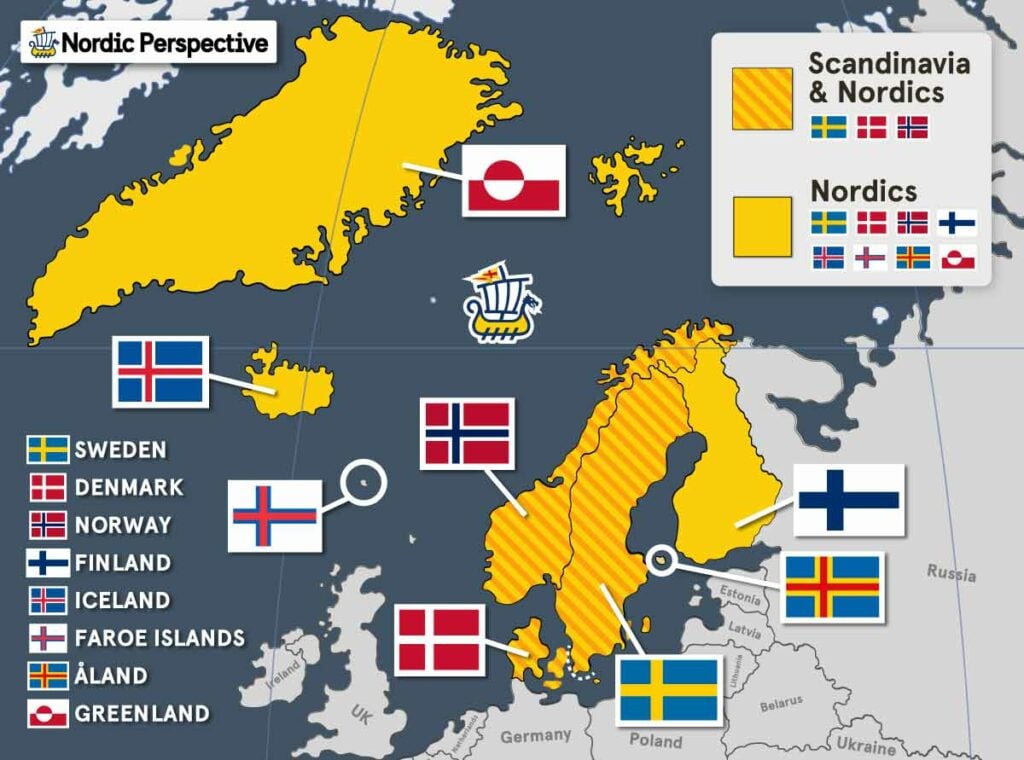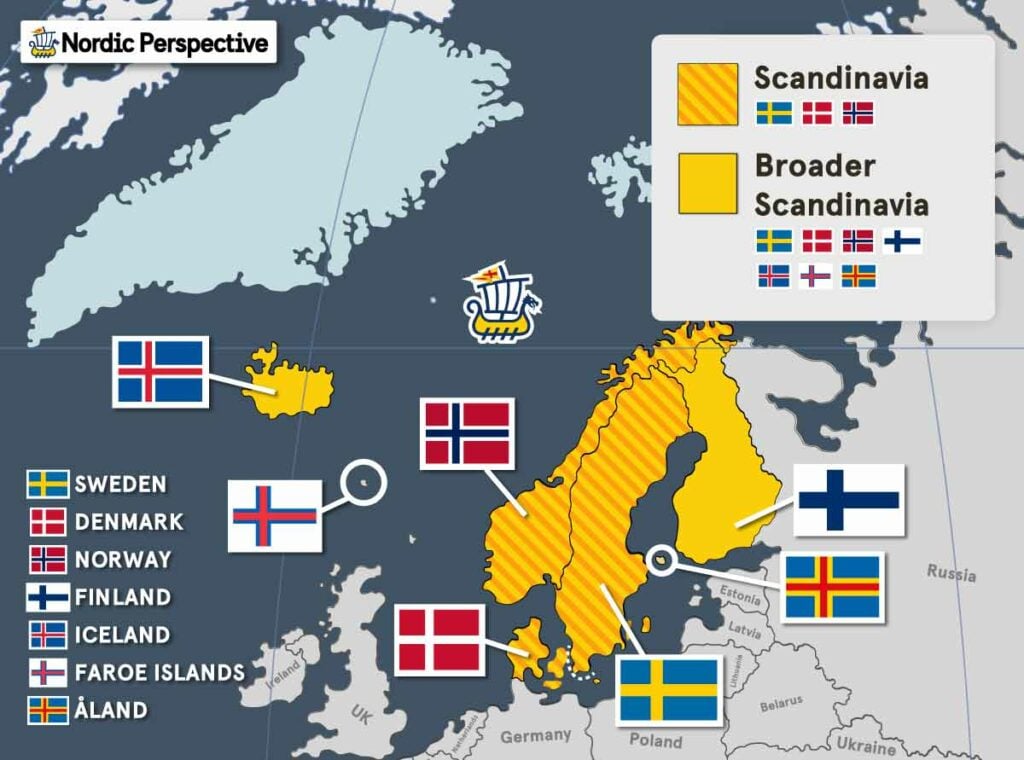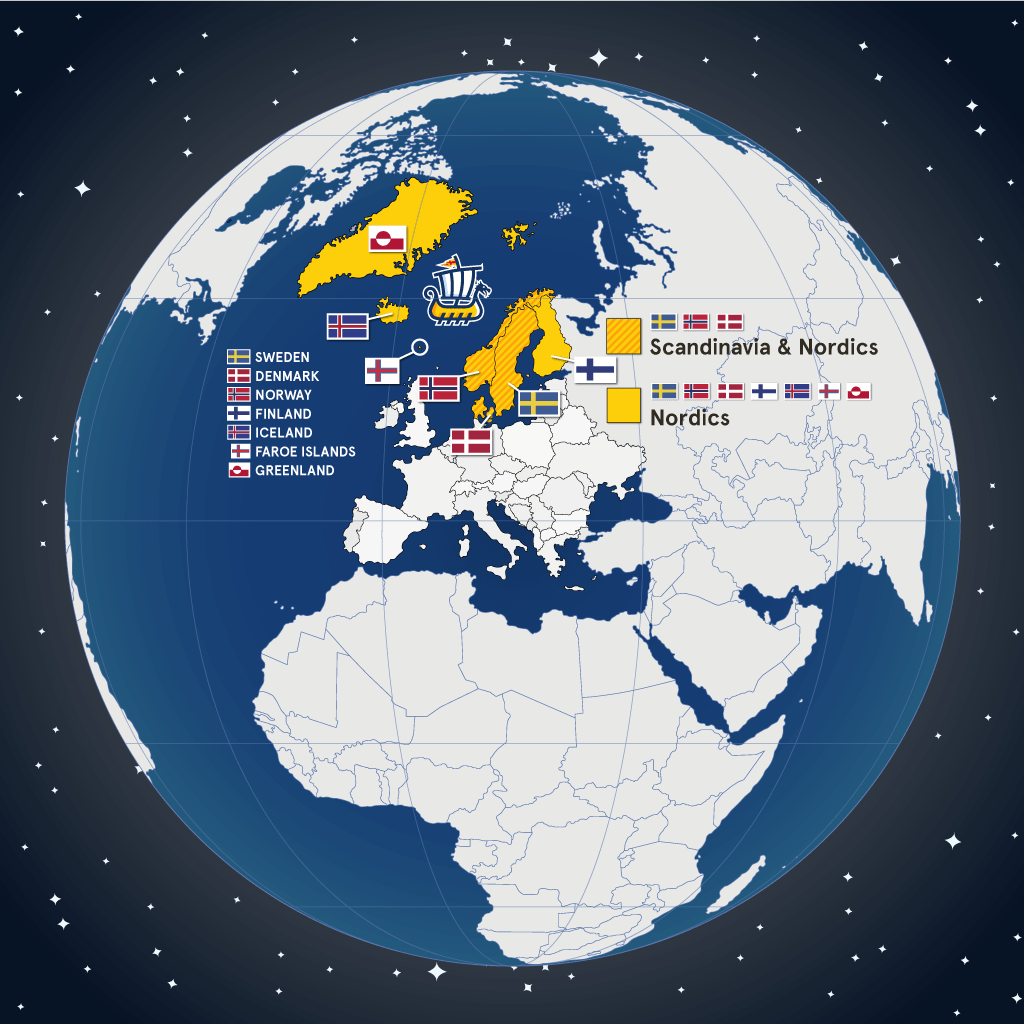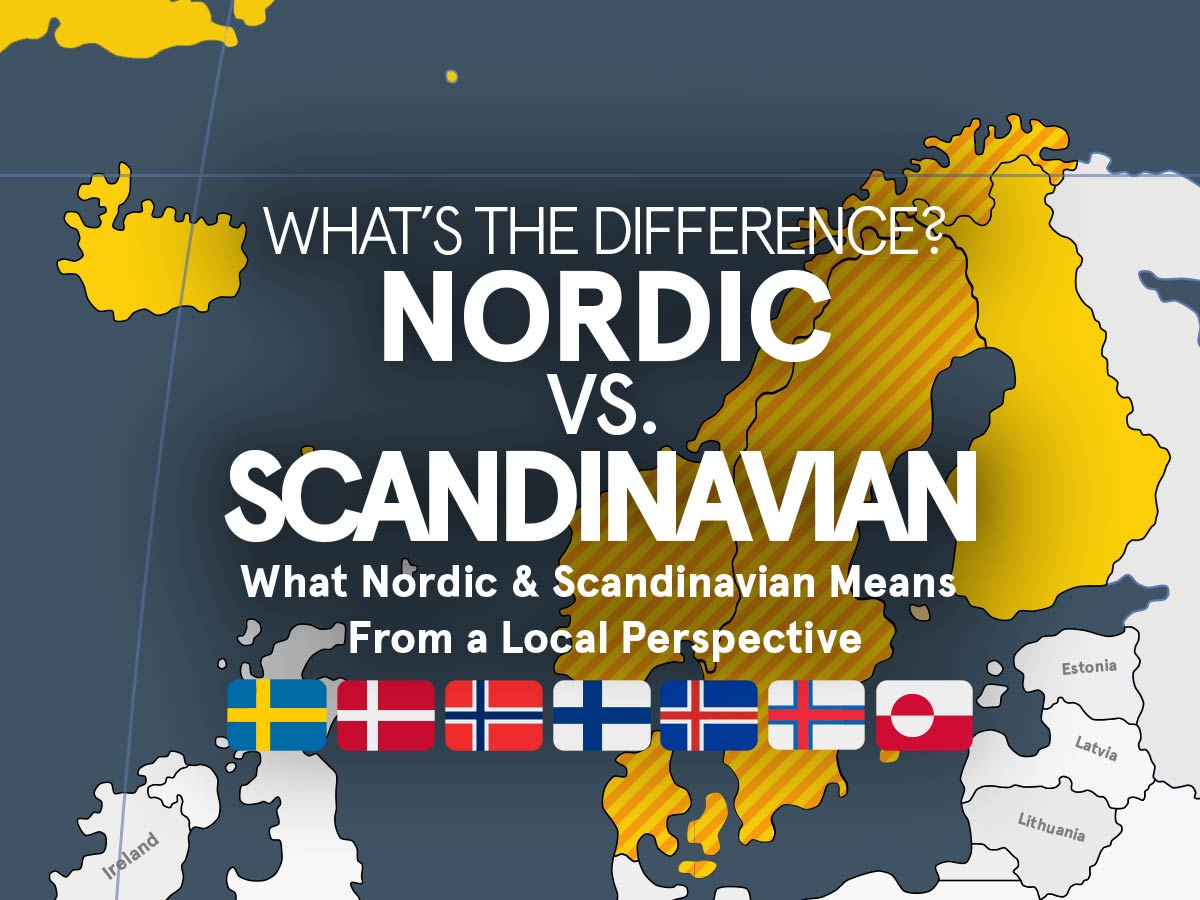Even people living in these countries sometimes struggle to explain the differences between being Nordic and Scandinavian. With good reason too, as there is a bit of a grey area among the global population on how to separate the two.
Being from Sweden with a Finnish mother, I am personally identifying as both Scandinavian and Nordic, but my Finnish family would likely not do the same, which I’ll get into a bit further down.
So let’s get into why it’s a bit tricky to separate the two terms!
What’s the difference between the Nordics and Scandinavia?
The Nordics is a geopolitical region that locally speaking (per the Nordic council) includes the three Scandinavian countries (Sweden, Norway, and Denmark), Finland, Iceland, as well as the autonomous territories of the Faroe Islands, Greenland, and Åland.

So within the Nordic region, only Swedes, Danes, and Norwegians call themselves Scandinavian, while the rest would likely prefer to be called Nordic (with Scandinavian roots and/or ties).
To confuse things, the English-speaking world mostly refers to a “broader Scandinavia” that not only includes Sweden, Norway, and Denmark — but also Finland and Iceland (as illustrated in the map below).

However, formally and locally speaking, Scandinavia is made up of Sweden, Norway, and Denmark, while the Nordics is made up of Scandinavia, Finland, Iceland, as well as the autonomous territories of Faroe Islands, Greenland, and Åland.
So why the confusion between Nordic and Scandinavian?
The main reason it gets confusing is likely that Finland, Iceland, Greenland, the Faroe Islands, and Åland all share a deeply interconnected history with the Scandinavian countries — an intricate web of historical connections, shaped by centuries of exploration, unions, and cultural exchanges.
Here’s how:
Finland & Åland was part of Sweden for over 600 years
Though Finland has mostly been made up of Finns historically speaking (who are Finnic in culture as opposed to the Germanic Scandinavians), Swedes settled the majority of the Finnish west coast and Åland (an island group located in between Sweden and Finland) around the Viking age, and live there still today.
Around the 12th-13th century and as a result of trade, settling, and alliances between the two people — as well as the looming threat of Russia in the east (sound familiar?) — Finland became part of the Kingdom of Sweden, a union which lasted until Finland was eventually ceded to Russia as part of the Treaty of Fredrikshamn in 1809.

This long-standing union introduced Swedish legal, linguistic, and administrative frameworks to Finland, profoundly influencing its societal development and the identity of Finns.
It should be added that far from all Finns look back at the “Swedish years” fondly — there were after all numerous violent raids and crusades by Swedes into Finland that preceded the more friendly trade and diplomacy missions — but the Swedish language remains one of Finland’s official languages, and is spoken by around 300 000 people out of the 5.5 million who live in Finland today.
Iceland and the Faroe Islands were both settled by Norwegians and later ruled by Danes
The settlement of both Iceland and the Faroe Islands in the 9th and 10th centuries was primarily the work of Norwegian Vikings. These settlers brought with them Scandinavian culture, governance, and language, laying the foundation for the Icelandic society we see today.
The Icelandic sagas, which chronicle the tales of the early Norse settlers and explorers — as well as the underlying Old Norse mythology — underscore Iceland’s historical ties to Norway and Scandinavia.
Iceland fell under Danish rule as part of the Kalmar Union in 1415, which lasted until 1918 when it gained indepence as a sovereign country. Still today, Iceland’s cultural and linguistic heritage remains closely linked to its Scandinavian origins, with the Icelandic language retaining a strong resemblance to Old Norse (the language spoken by Scandinavians during the Viking age).
So in other words, most (but not all) Finns would likely prefer to be called Nordic rather than Scandinavian, while Swedes, Danes, and Norwegians (+ Ålanders if we want to be precise) likely would describe themselves as Scandinavians first.
At the same time, Icelandic and Faroese people would agree that both they and their language are of direct Scandinavian descent — something the Finns would never dream of — but they still call themselves Nordics instead of Scandinavians (which the Finns would also do).
And finally, Greenlanders would likely refer to themselves as being of Inuit heritage and culture, while being and autonomous part of the Scandinavian Kingdom of Denmark.
Phew… no wonder people get confused!
To make it even easier to separate the two terms, I have compiled a table with a quick overview of the formal and informal differences between the terms Nordic and Scandinavian:
| Nordic | Scandinavian | |
|---|---|---|
| Meaning: | “Of the north” | “Of Scandinavia” |
| Geographical area: | Northern Europe (excluding British Isles, Baltics, European Russia) and Greenland | Scandinavian and Jutland peninsulas, Danish islands in between, and Swedish Islands in Baltic Sea |
| Countries formally included: | Sweden, Denmark, Norway, Finland, Iceland, Faroe Islands, and Greenland | Sweden, Denmark, and Norway |
| Countries commonly and broadly included: | Sweden, Denmark, Norway, Finland, Iceland, Faroe Islands, and Greenland | Sweden, Denmark, Norway, Finland, Iceland, and Faroe Islands |
| Common historical/ethnic background: | Mostly* (* The Finns, Greenlanders, and the Sami minorities in Sweden and Norway do not share the same ethnic background as the rest) | Mostly* (* The Finns and the Sami minorities in Sweden and Norway do not share the same ethnic background as the rest) |
| Common modern-day cultural background and values: | Yes | Yes |
Now, for those of you who want to learn even more about these two regions, let’s dig a bit deeper and look at the two terms and regions individually, starting with the Nordic region:
The Nordic Region
The Nordic region includes the five Northern European countries of Sweden, Denmark, Finland, Norway, and Iceland, along with the three autonomous territories of Faroe Islands, Greenland, and Åland.

These countries and territories are tied together culturally, historically, financially, and politically; specifically when it comes to the following areas:
- Democratic and political rights
- General transparency and low levels of corruption
- Trust between each other and toward the government
- Population feels safe
- Social unity
- Gender equality
- Distributing incomes via taxation
- Similarly high Human Development Index
The Meaning of Nordic
The Nordic region refers to the Northern European countries of Sweden, Norway, Denmark, Finland, Iceland, Faroe Islands, and Greenland. Most of the region can also be referred to as Scandinavia.
So, is it basically just Northern Europe then?
While Nordic can generally be used synonymously with Northern European, there are a few differences; You would not refer to the British Isles, the Baltics, or the European parts of Russia as Nordic, but they are all considered Northern European.
ℹ️ The Nordic countries are more commonly called Norden locally, which literally means “the North”. In the Nordics you would similarly refer to a Nordic person as Nordisk which means “of the North”. This infers that Nordic means “of the North” as well.
Other Regions with Ties to the Nordics
The following regions all have a connection to the Nordics through cultural, ethnic, or historical ties:

- Ireland (in which every city today was founded by Norsemen)
- the Northern Isles of Scotland (colonized by Norsemen)
- Estonia (pursued membership before WW2)
- Germany (shared germanic cultural and ethnic ties)
- the Netherlands (shared germanic cultural and ethnic ties)
- Belgium (shared germanic cultural and ethnic ties)
- France (shared germanic cultural and ethnic ties, the Norman connection)
- Ukraine (colonized, influenced, and partly founded by Norsemen)
- Russia (colonized, influenced, and partly founded by Norsemen)
Why isn’t Estonia Nordic?
While the country did pursue membership after becoming independent in 1918, Estonia isn’t part of the Nordics today because the process of gaining membership alongside Finland was interrupted by the Soviet occupation during World War 2. If it weren’t for that, Estonia would likely be considered part of the Nordic countries today.
It might be a meme on internet forums at this point, but Estonia has been under Scandinavian influence since the Viking days, and the country was actively pushing towards being defined as a Nordic country after its war of independence in 1918. Today more than half of its young population consider belonging to the Nordic identity group important or very important.
The Nordic countries are still Estonia’s most important trade partners, and before the Societ occupation, there were a large number of Swedes present in the coastal areas of Estonia (25% of the population of Tallin, the capital of Estonia, were for example Swedes).
A study in 2020 by the University of Tartu also showed that 6th graders today felt a stronger affinity to Sweden, Finland, and the other Nordic countries, than to neighboring Baltic countries Latvia and Lithuania. This has been observed in other studies as well, moving the Estonians closer and closer toward the Nordics, at least in the minds of their next generation.
The Scandinavian Region
Locally and technically speaking, Scandinavia refers to the countries of Sweden, Norway, and Denmark (all speaking the Scandinavian languages and home of the Norsemen/Vikings of pre-medieval fame).
However, for most of the English-speaking world, Scandinavia can more commonly refer to Sweden, Norway, Denmark, and additionally Finland, Iceland, and the Faroe Islands, alluding to a larger geographical, political, and cultural group.

The Meaning of Scandinavia
It is believed that Scandinavia comes from the germanic Skaðin–Awjō (pronounced “ska-tin-aw-jo”). Skaðin means “danger” or “injury”, and Awjō means “island” or “land next to water”.
This would suggest that the word Scandinavia means “Dangerous Island”, which is thought to be referring to the treacherous waters and sandbanks around Scania and Jylland, which have likely been the cause of a lot of maritime troubles over the years.
It is likely also the origin of Scania (the region of Skåne in southern Sweden) and Skanör (a town in southwestern Skåne).
The name was mentioned by Pliny the Elder when he referred to the region as Scatinavia in his writings from 77 CE, and around 500 CE Jordanes used the term Scandza to describe where the Goths came from.
For more information about the where the name came from and what it means, I’ve written an article where I dig deeper and explain the roots of the word Scandinavia in more detail.
The Scandinavian Peninsula and the Scandinavian Countries
The Scandinavian peninsula is located in Northern Europe and contains the countries of Sweden, Norway, the northwestern part of Finland, and a small slice of northwestern Russia. It lays north of Germany, and west of Russia and the Baltics.
That means two out of the three Scandinavian countries are located on the Scandinavian peninsula, as it does not contain Denmark (which is located on the Jutland peninsula and its 443 islands).
For more information about how the Scandinavian countries are connected, I’ve written an in-depth look at the ties between the Scandinavian countries, and why people sometimes think they are all one and the same country.
Quick answers about the Nordics and Scandinavia
Which Countries are Nordic But Not Scandinavian?
There are two sides to this:
1. The original and locally preferred view is that Iceland, Finland, Faroe Islands, and Greenland are all countries considered to be part of the Nordics, but not technically part of Scandinavia (which would only be Sweden, Norway and Denmark in this case).
2. The international and more commonly preferred view is that the Faroe Islands, Finland and Iceland are part of both Scandinavia and the Nordics, leaving Greenland as the only non-Scandinavian country in the Nordics (along with the Norwegian territories of Svalbard, Jan Mayen and Bouvet Island).
Do All Nordic Countries Have Viking Heritage?
The Nordic region as a whole has a very strong connection to the Norse, and they did indeed have kingdoms and settlements in all of the Nordic countries at some point, all originating from Sweden, Denmark, and Norway. The Nordic country with the least norse influence is Finland, where the vikings mainly settled in the Åland islands and parts of the west coast (they did stop in Finnish ports along the way east towards what would become the Viking Gardariki in the Rus lands).
If you are feeling a bit overwhelmed by all the terms, I have gone through the differences between Nordic and Norse in greater depth.
Is Scandinavian a Race or an Ethnicity?
There is no Scandinavian race, but some anthropologists in the 19th and 20th century used to refer to a Nordic sub-race to the Caucasian race. As studies in modern genetics progress, the concept of race is becoming obsolete, and has since been disproven. There are however some common traits among the Scandinavian people.
Scandinavian as an ethnicity has generally and traditionally referred to the speakers of the Scandinavian languages and descendants of the Norsemen. However, there has been a strong move in modern days towards being more inclusive and referring to all citizens of the Scandinavian countries—and even those of Finland, Iceland, and the Faroe Islands as well—when talking about what the term Scandinavian means today.
Which Scandinavian Countries are in the EU?
Sweden and Denmark (and Finland for those including the Finns in Scandinavia) are the only Scandinavian members of the European Union. Denmark was the first Nordic country to become a member in 1973, followed by Sweden and Finland in 1995.
Which Scandinavian Countries are not in the EU?
Norway, (and Iceland, and the Faroe Islands) are not members of the EU, but generally referred to as being part of Scandinavia (countries in parenthesis aren’t formally part of Scandinavia).
Do All Scandinavian Countries Accept Euro?
Sweden, Denmark, and Noway do not use the Euro as they all have their own currencies: Swedish krona, SEK; Danish krone, DKK; Norwegian krone, NOK. They have all voted on whether or not they should adopt the Euro, but the Scandinavian population has so far voted against joining the eurozone.
There is however one country in the region that does use the Euro; Finland. The Finns are the only Nordics with the Euro as their single currency, and has been part of the “eurozone” since 1999.
Summary
So, there is no doubt a sizeable grey area when it comes to separating the terms Nordic and Scandinavian — especially among the locals.
But generally and internationally speaking being Nordic and being Scandinavian essentially means the same thing: being a citizen of either Sweden, Denmark, Norway, Finland, Iceland, or the Faroe Islands (with Finland sometimes considered the odd one out as they do not share the same Norse heritage as the other countries).
Sources:
http://www.carlaz.com/phd/cea_phd_abstract.pdf
https://en.wikipedia.org/wiki/Natural_History_(Pliny)


Short history Denmark – Norway – Iceland (+ Sweden)
1262: Iceland and Norway with the Faroese Islands and Greenland, unify.
1388: The Kalmar Union is signed, when Sweden, Denmark and Norway, with Iceland, the Faroese Islands and Greenland, unites under one crown.
1523: Sweden leaves the union.
Now Norway, together with its islands, ends up under the Danish Crown, but with its own government. This is a situation that has minor changes a couple of times, but of no practical matter.
1814: After the Napoleon war, and the Swedish loss of Finland, the peace treaty of Kiel made Denmark leave Norway, only the mainland, to Sweden. That became the Swedish – Norwegian Union, and Norway was NOT happy. Automatically Iceland, the Faroese Islands and Greenland became Danish, not by a union, just plain Danish.
1905: Sweden unwillingly lets the even more unwilling Norway leave the union.
1918: Iceland becomes an autonomous state, by a covenant, still under the Danish crown.
1944: Denmark is under German occupation. The Danish – Islandic agreement ends in June 17, and Iceland becomes a free state.
However, the Faroese Islands and Greenland still remained Danish.
Iceland wasn’t a sovereign state until 1944.
Anyway, THANKS for explaining the Nordic – Scandinavian (and sometimes also Baltic) mystery! One of these days we might confuse the rest of the world even more, if we join with the Baltics, creating the ‘Noltics’!!